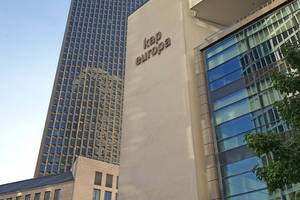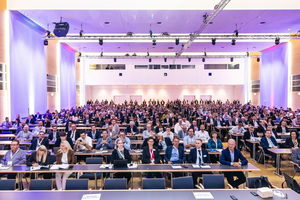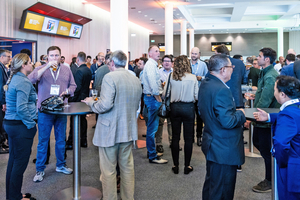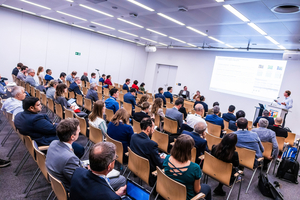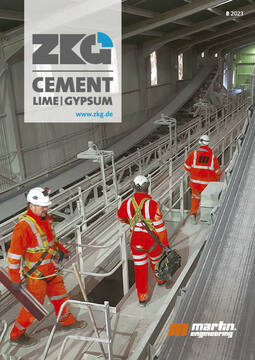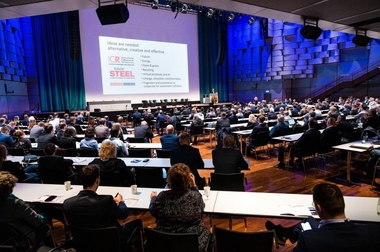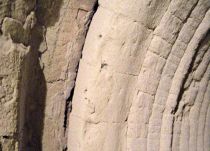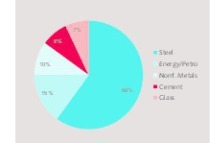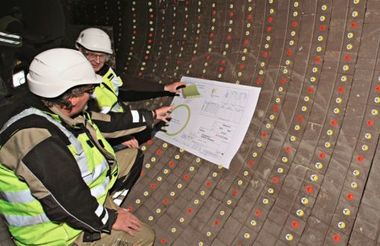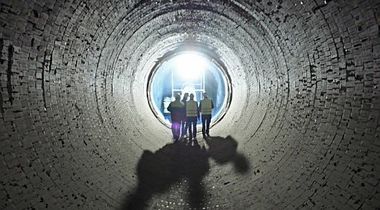Refractories presents itself as a sustainable industry
More than 1100 participants attended the Unified International Technical Conference on Refractories (UNITECR) that was held in Frankfurt/Germany from September 26th-29th, 2023.
The number of participants was more than ever before at a comparable conference. A scientific committee invited 219 speakers from 330 topics submitted. In addition, 53 researchers were allowed to present their work on posters.
The main theme of the event was “The Carbon Challenge”, a current positioning of the refractory industry on the challenges in product manufacturing and application in the customer segments of steel, cement or glass.
The current topic also attracted a much younger field of participants than in the past:
“More than 53% of the participants were younger than 45, we even had 39 students and were able to welcome 237 female participants,” said a pleased Thomas Kaczmarek, who was responsible for the overall organisation.
In the course of the registrations, two special events were prepared for this development:
Women@Refractories (supported by RHI Magnesita) and
Young Professionals (supported by Refratechnik)
“Both events had the aim to face this change openly and to create new networks. We are of course very pleased that we could feel these developments here in Frankfurt and expand both formats for future conferences.”
Women@Refractories took place on Wednesday evening. More than one hundred participants were counted, who were able to exchange information about the different professional and personal backgrounds of four female speakers and about various career paths, highlights and challenges in the refractories industry.
On Thursday, students were invited to meet at the REFRAup Lounge to learn about the latest developments in the use of virtual reality in refrac-tories manufacturing and application.
53 researchers were allowed to present their work on posters, which were part of the exhibition. Of these poster exhibitors, 23 authors applied for the Poster Award, which was supported by the companies Steuler and Göller Verlag. Under the moderation of Prof. Dr. Christos G. Aneziris (UNITECR 2023 Vice President) and Dr. Christian Dannert, the participants had to explain the most important technical features of their work within one minute in front of more than 100 spectators. The forms of presentation ranged from rapid speech, to singing and even magic. The expert jury consisted of Chris Parr (Imerys, Chairman), Jens Sperber (Steuler) and Karin Scharrer (Göller Verlag) and judged the three best presentations according to their successful performance.
During a formal ceremony at the conference dinner at the Palmengarten on Thursday evening, three individuals were honoured as Distinguished Life Members (DLMs) for their lifetime achievements and outstanding contributions in the field of refractory science and technology or in the field of management and exemplary support of UNITECR’s philosophy.
Cement and Lime
Two sessions were dedicated to cement and lime topics. Dr. Volker Wagner, Heidelberg Materials AG, started with the “Challenges for a cement producer”. Changing clinker production conditions as caused by continuously increasing alternative fuel rates or new production technologies were the basis of new developments in the field of refractories. Producers are looking for a continuous production without any unplanned stoppages; a reliable refractory lifetime predictability for any application area is required. A deeper look into the refractory material and therefore the detection of potential damage/pre-damage is a problem to be solved. The help could come from sensors for metallic anchors providing information about “remaining” lifetime or sensors for the degree of brick infiltration to detect when the first cracks might appear.
Bastian Vesenberg, EKW GmbH, presented the paper “Near-customer engineering management for advanced applications in the cement industry” (Authors: Bastian Vesenberg, Nicole Schlimm, Daniel Cölle, all EKW GmbH, Germany; Dr. Thomas Weiss, Lennart Hapke, both IKN GmbH, Germany) outlining the route to the realization of a technologically advanced alkali-resistant and particularly abrasion-resistant high-temperature material with reliable thermal shock behavior, from the idea through the development process to the final product. Novel testing methods are integrated into the development like alkali tests at 1100 °C using potassium carbonate and sodium carbonate on the one hand and potassium sulfate and sodium sulfate on the other mark reliable results for the functional stability of the refractory ceramics in corrosive process routines. The design and prototyping of preformed components was used to successively optimize the material properties under real conditions close to the customer. A particular challenge was the adjustment of certain structural properties in order not to lose the resistance of the refractory ceramics to erosively acting particle streams and gases in favor of a robust behavior against abruptly occurring load peaks, for example abrupt temperature changes or locally occurring pressures. For this purpose, a test procedure was developed to test the so-called impact behavior under hot conditions, and both interventions in the bonding system of the refractory material and in construction elements led to improved robustness of impact zones. The aim of optimizing the material, from an economical point of view in particular, was fulfilled, which was confirmed by the successful application on the customer’s plant site. The potential transferability of the product solution to other industries was demonstrated, e.g. in the aluminum industry.
Dr. Hans-Jürgen Klischat, Refratechnik Cement GmbH, delt with “Effective CO2-reduction for rotary kiln burning processes by using energy efficient linings” (Authors: Dr. Hans-Jürgen Klischat, Dr. Stefan Puntke, Holger Wirsing, Peter Groger, all Refratechnik Cement GmbH, Germany). To reduce carbon released from the material burning process, new lining concepts have been developed by designing a new fine-ceramic microstructure. These novel basic and non-basic brick grades with porosities up to 25% reduce the heat losses due to their exceptional low heat transfer. All other properties, including refractoriness, strength, structural elasticity, permeability, and thermal shock resistance are kept at values which are well-proven for the application in rotary kiln linings. Emphasis was also laid on kiln linings which are exposed to increased alkali atmosphere, as a result silicon carbide containing high alumina bricks are an essential part of this energy saving concept. The installation of these new products is as easy as for standard products, no additional effort like two-layer-linings is necessary. The results of recent installations show a significant decrease of the kiln shell temperature. The reduction in overall CO2-emission is calculated to 2%, which is enormous considering the already well-matured rotary kiln process and the installation in passing. Beneath a lower lining weight, even reducing the operating power, the reduction of 10% in material use is responsible for an improved sustainability and reduced carbon footprint not only for the kiln operator, but also for the refractory producer, and the environment.
“Energy-saving refractory bricks for sustainable lining of rotary kilns” was the topic of the contribution by Dr. Ufuk Akkasoglu, Kumas Manyezit Sanayi A.Ş. (Authors: Dr. Ufuk Akkasoglu, Gorkem Yanik, Nuri Sarioglu, all Kumas Manyezit Sanayi A.Ş., Turkey). Reducing carbon footprint is a significant challenge for energy-intensive industries – including cement and lime – due to the usage of extensive thermal processes in production. One possible way to decrease energy consumption is using an energy-saving lining in which the thermal conductivity is reduced by increased porosity. However, mechanical, chemical and thermal limitations of the rotary kilns should be considered in brick design since porosity will degrade relevant properties. Novel basic refractory bricks with reduced thermal conductivity were developed to reduce kiln shell temperature and hence reduce energy consumption. Different pore-forming agents and their influence on microstructure as well as physical, mechanical and thermal properties were investigated. A novel energy-saving basic refractory brick with reduced thermal conductivity by induced porosity is developed without compromising the refractoriness as well as mechanical and thermal properties.
“Customized linings for upper transition zones of rotary kilns for contemporary cement clinker production conditions” were shown by Holger Wirsing, Refratechnik Cement GmbH (Authors: Holger Wirsing, Dr. Carsten Vellmer, Dr. Hans-Jürgen Klischat, all Refratechnik Cement GmbH, Germany). Refractories for linings of cement clinker rotary kilns have been developed according to the process conditions resulting from the mineral phase transformations of the kiln feed and the kiln gas atmosphere. Even under standard conditions the requirements for refractory bricks used for linings in the upper transition zone are complex, and the increasing use of alternative fuels and raw materials intensifies the loads drastically. In kilns with thermal substitution rates exceeding 80%, especially in the upper transition zone, burning conditions again became more severe. New combinations of the brick’s hot face temperature, kiln shell temperature, oxygen content, concentration of volatile compounds, new compounds and clinker melt activities never observed before in that area, are then constantly present or occur as temporary effects. Refractory lifetime monitoring, lining inspections, and post-mortem investigations showed that lining concepts have to be reviewed and adapted. To meet this increasing demand, refractory brick materials have been developed to withstand these stress combinations in a better way. The refractory linings used today in the upper transitions zones of cement clinker kilns with high thermal substitution rates are designed to cope with the specific combinations of stresses. This includes not only new non-basic brick types with high resistance to sulphur oxide attack, but also linings for better performance that directly and indirectly contribute to a reduction of emissions and to energy savings.
Makoto Ohno, Mino Ceramic Co., Ltd., dedicated his presentation to “Refractory linings for cement rotary kilns contributing to environmental impact reduction” (Authors: Makoto, Shiho Takeuchi, Yasutaka Yoshimi, all Mino Ceramic Co., Ltd., Japan). Refractory manufacturers can primarily contribute to the efficiency of the cement burning process by providing durable and energy-saving refractory linings. From the viewpoint of environmental footprint reduction, many cement plants have been using a larger amount of alternative fuels (AFs) and alternative raw materials (ARMs), however, this has caused premature wear of refractories inside kilns. Additionally, with regards to thermal energy released from the process it seems not much effort has been made about the reduction of heat radiation from the kiln shell surface, whereas a lot has been implemented about recovery of waste heat from exhaust hot gases. The latest progress on the development of a magnesia-spinel brick coping with the increasing use of AFs and ARMs and an alumina-silica brick contributing to shell temperature reduction was presented. Based on the postmortem analysis of bricks collected in transition zone, changes in the amount and balance of alkali, chlorine and sulfur infiltrated were one of the major influential factors that increased the brick wear. Consequently, a magnesia-spinel brick was developed that adapts to environmental changes by creating an optimal microstructure through control of the brick’s trace components. In view of reducing heat radiation, a low thermal conductivity alumina-silica brick with increased silica content and moderate porosity was also developed.
UNITECR 2025
During the conference dinner the venue for the next UNITECR in 2025 was announced by Mauro Cueva, President of the South American Refractories Association, ALAFAR: Cancun/Mexico, October 27th-30th, 2025.

